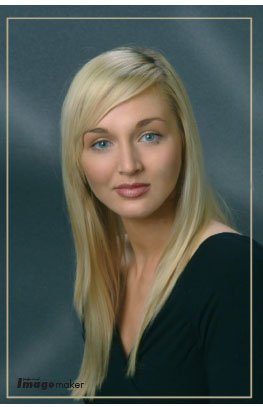articles/Portraiture/physiognomy-page3
Physiognomy PORTRAITURE and the Study of the Human Face - part 3 of 1 2 3
by Dave Newman Published 01/02/2005

A FEW HELPFUL GUIDELINES
The following few remedies are useful to specific applications, but they represent only a few corrections in a long list of solutions to facial problems that we must remember and work with. A double challenge to the professional portraitist occurs when the subject's facial structure requires employing more than one of these corrective measures and procedures at the same time. The best remedy may often be to use only the most effective of the two. Often, corrective procedures used in tandem become conflictive and even useless.
Double Chins and Heavy/Round Face:
Use a projection stretch of the neck to "turtle" the head forward. Ask the sitter to lean and stretch forward as if to touch the camera with the tip of their nose. Avoid low camera angles.
Prominent Ears:
Use short-lighting in a 2/3rd view of the face. Turn the head until the far ear is totally hidden.
Deep Set Eyes:
Try lowering the key light. Avoid high ratio lighting.
Prominent Nose:
Shoot straight into the tip of the nose. Raise the face as needed. Avoid high camera angles.
Poor or Crooked Teeth:
Avoid cross-lighting. Include poses with a pensive, closed mouth expression. Always reassess the teeth under various lighting angles, looking for protrusive and uneven teeth. (Note: overly grim and pensive portraits taken in the 1800s were often due to the poor dental conditions of the sitter. We must be sensitive to the fact that modern practices and procedures in dentistry have lead to the expectation of "perfect" teeth in every portrait.)
Uncontrolled Blinking:
Caused primarily by the "flinch" after hearing the noise of the camera prior to the exposure. Try using the mirror lockup setting. Avoid working in an extremely quiet camera room....add music to mask these culprit camera sounds.
Lazy or Weak Eye:
Methods vary, but asking the subject to look at an object located in a distant corner of the camera room can often solve the problem.
Glasses and Eyewear:
My favorite method is to raise the key light much higher and add a bounce "white" card onto a table in front of the subject. This works, of course, for head and shoulders poses only, by adding "up-light" which opens eye sockets and causes only a slight touch of hazing into the glasses. Other methods include careful removal of lenses from the frames, changing angles and raising key light. Also, you might try tilting the glasses and raising the ear pieces slightly above ears (works best when the ear pieces can be hidden in up into the long hair of the subject).
A word to portrait artists about using Photoshop™.Adobe Photoshop™ is the most important enhancement tool of our generation, but becoming an addict to this post production repair can reduce your effectiveness as portrait artist. As a general rule; don't rely on Photoshop™ to solve your problems. Often investing a few seconds making corrections with your subject in the camera room can save time-consuming efforts in the computer processing of your work.
Please Note:
There is more than one page for this Article.
You are currently on page 3
- Physiognomy PORTRAITURE and the Study of the Human Face page 1
- Physiognomy PORTRAITURE and the Study of the Human Face page 2
- Physiognomy PORTRAITURE and the Study of the Human Face page 3
1st Published 01/02/2005
last update 09/12/2022 14:57:55
More Portraiture Articles
There are 0 days to get ready for The Society of Photographers Convention and Trade Show at The Novotel London West, Hammersmith ...
which starts on Wednesday 15th January 2025





